Recently Chandra and I found ourselves in India for a good friend’s wedding. It wasn’t our first trip to India so we thought we’d check out a neighboring country while we were there and managed to get very reasonable flights up to Nepal. After the wedding in Goa we flew back to Mumbai and then up to Kathmandu spending the night at the lovely Hyatt Regency Kathmandu (definitely Style Hi) in the shadow of Boudhanath Stupa. The obvious activity was trekking in Nepal. The city of Kathmandu seems to be built on trekking. Every foreigner you see is either about to go trekking or just returning so logically it seemed like the thing to do.
We arranged with Utmost Adventure Trekking to do a three day trek around the Kathmandu valley. As mountain trekking isn’t really our thing, this seemed like the lightest, easiest possible option.
We had bought fancy gear in NY and were ready for anything after cleverly packing our small packs with only the essentials. We were ready to go and very excited. We met Mahesh who would be our guide for the next three days. It was a little drizzly out so Mahesh suggested maybe we drive the first day’s distance and start tomorrow. Chandra and I would hear none of this. We were hear to trek, we had all the fancy rain equipment and we were ready to go. We weren’t going to let a little drizzle stop us. Let’s do it! We insisted. We set out to our starting point – Sundarijal – about 90 minutes away from Kathmandu. I really had no idea what to expect from the trek. I thought I did. But I didn’t.

Dave & Chandra in Sundarijal at the beginning of the trek. If only we knew what we were getting into…
We started up a series of stone sets of “stairs”. They seemed to have hundreds of steps in each and were very difficult to deal with. Around this point Mahesh told us the first three hours would be like this. That was certainly discouraging news. The plan was to hike 4.5 hours today from Sunjdarijal to Chisapani. Then stay overnight in Chisapani and trek six and a half hours the next day to Nagarkot. Then the third day trek the final three and a half hours from Nagarkot to Changunarayan where we’d drive back to Kathmandu. Four and a half hours of trekking didn’t seem so bad on paper but now that we were doing it and realized it was going to be almost entirely up hill…things seemed a bit more difficult. No matter though, we would prevail.
The first part of the trek was excruciating. Steps, steps, more steps. We ascended up from the town of Sunjdarijal out into a more rural area passing by a big dam and eventually coming to an entrance gate for Shivapuri Nagarjun National Park’s Sundarijal entrance. We continued up and up from there into the village of Mulkharka. The rain was light and wasn’t causing any real problems. We decided to stop in Mulkharka for lunch which was fantastic since walking another step uphill at this point seemed impossible. While we sat and ate the rain became much harder. It was now pouring out really really hard but by the time we were finished eating, it had calmed down back to barely anything at all. Don’t we just have the best luck? We still had a very long way to go. We would find out later that the total distance we had to cover today from Sundarijal to Chispani was 15km, or 9 miles.
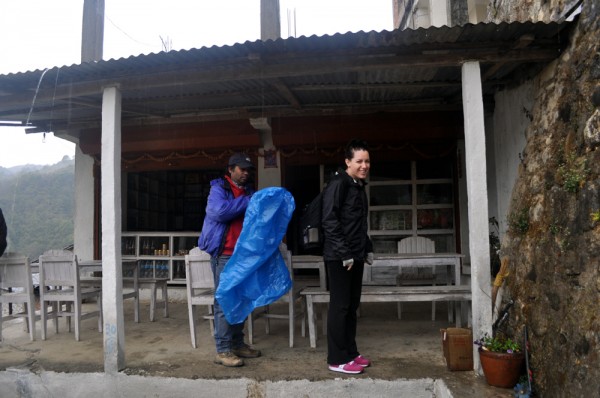
Chandra & Mahesh Stop for Lunch at Mulkharka. Chandra’s coat has been replaced at this point with a giant blue plastic triangle.
Continuing from Mulkharka the trek continued uphill. Sometimes there were “stairs” sometimes just horrible slanted trail. Broken rocks made up most of it and you had to be looking at every step you took or you may fall and twist your ankle. To make matters (much) worse, the rain started to get worse. Much worse. Not too long after leaving Mulkharka our luck ran out and it started to pour. We stopped one more time for a short break before leaving the “developed” portion of the trek altogether and entering pure National Park where we’d continue through forests of oak and rhododendron.
The rain was in full force and with no more steps or places to stop for shelter, it was just us, the mud, and the rain with many miles to go before we reached Chisapani. The walk was relentless. As the rain came down harder and harder we continued uphill with the water running back down towards us. Every step was treacherous and threatened to send us off our feet and into the mud. Finally we reached what Mahesh told us was the highest point on the trek. It was marked with Tibetan Prayer Flags as is the tradition. We continued over the peak as if coming to the crest of a roller coaster and no longer were burdened with walking uphill. By this point we were completely drenched. Our rain gear didn’t make a difference, every part of us was totally saturated, shoes, sox, pants, everything. Even the plastic bag I had my camera in somehow now had water in it. It couldn’t be avoided.
On the descending trail we were told we had another hour before reaching Chisapani. It took more like 2 thanks to the rain. If we thought walking uphill in the rain was difficult, walking down was even harder. We were walking through heavy mud and every step we were slipping and trying not to fall. But falling couldn’t be avoided entirely. It happened to me once and Mahesh twice. Chandra managed to avoid that fate. After what seemed like forever and WAY longer then Mahesh told us…we emerged from the trail and entered Chisapani roughly six hours after leaving Sunjdarijal. We could not be more uncomfortable. All I could think about was getting to the Hotel Mountain & Galaxy Restaurant teahouse, getting to our room, taking off all my wet clothes and putting on pajamas and sitting by the fire or heater and having something warm to eat/drink. But as it turns out, things were about to get even worse.
Shivering and uncomfortable we took off our wet clothes and unpacked our bags. Everything was soaked. All of the clothes we had brought, replacement pairs of socks, pajamas, it didn’t matter, it was all wet and freezing cold. The room had no heat, in fact neither did the entire teahouse. They didn’t have any electricity at all, it had gone out yesterday apparently and there wasn’t nothing they could do about it. The bathroom attached to our third floor bedroom was basically outdoors. The roof just a single piece of corrugate aluminum being held up by tree branches. There was absolutely no insulation in the room at all and it was the same temperature as outside. We could see our breath it was so cold and we had nothing but wet clothes to put on after taking our wet clothes off. This was not going well at all. We climbed immediately into bed and laid next to each other shivering. It was impossibly cold in the room and having only soaking wet clothes (especially socks) was making it unbearable.
We tried sitting downstairs in the common area and having some hot chocolate and tea but with no heat at all and no power, the room was the same temperature as outside (probably in the 30’s Fahrenheit) and equally horrible. We ended up quickly back in bed trying to keep warm like two hypothermic people trying to stay alive. Mahesh got us a couple of bowls of soup which we had in bed and I worked on convincing Chandra that we were in fact not going to die. It was only about 7pm at this point, but it was clear our day was over. The idea of getting out of bed again seemed impossible. Plus the entire place was absolutely pitch dark. The rain had ruined this experience in every way. Things were sucking. Mahesh was great though. He came back later and asked if we wanted a proper dinner and took our orders and got us food. Chandra had some fried rice. To change things up a bit I had a mushroom pizza – a hilarious thing to order in such a place.
The next morning it was time to talk about our options. It was no longer raining and we thought the best option would be to drive from Chisapani to Nagarkot instead of walking that leg and then dry off for the day in Nagarkot before continuing on to Changunarayan on foot tomorrow. That’s when Mahesh told us that driving to Nagarkot was not possible because where we were in Chisapani was not accessible by road. This left the following options:
- Continue onward to Nagarkot in our soaking wet clothes on a hike that would probably take close to eight hours because of all the flooding from yesterday.
- Backtrack along the same trail we used yesterday and return to Sundarijal.
- Live in Chisapani forever.
Ultimately we chose to return back to Sundarijal on foot. It wasn’t what we wanted to do but given the options we didn’t have much choice. After a simple breakfast and taking some photos with the stunning mountain views that we couldn’t see at all yesterday, we set out on the long trail back. Our clothes were still totally soaked and covered in mud and all of our electronics were either dead or broken. My DSLR wouldn’t turn on at all due to water damage.
We left at 9 on the dot and hoped we could be back in Sundarijal no later then 2pm. The weather was stunning. The air so clean and crisp, the sky so clear. Birds were chirping and in the distance we could see the mountains that make Nepal so famous. Did you know 8 of the world’s 10 highest peaks are here in Nepal? The treacherous mud soaked walkways of yesterday had been transformed into a pleasant walking trail.
We continued through the national park, unlike yesterday people were passing us in either directions. Groups of people, old men and women walking without shoes carrying heavy bags – the trail was alive with activity. Unlike in the pouring rain of yesterday, villages we past were bustling with people. Kids were in school, weddings were taking place, cows were moo’ing, roosters cock-a-doodle-do’ing and goats running all up and down the place. The downhill walking was making my knees felt like they’d break off at any moment. We stopped someplace Mahesh suggested for lunch in Mahankai but we didn’t want lunch, we wanted to get back to Sundarijal so we just shared a coke and kept on truckin’.
Finally we passed the big dam. It was the home stretch now. Just a few hundred more stairs I think and we’d be back in town. Step step step. Each step had our knees and legs aching in pain but it kept looking more and more developed up ahead. Was this building something we remembered yesterday upon leaving? Not sure. Step step step step. Then I think at about 1:40 it happened. A bunch more steps and then off in the distance we could see a bus. A bus meant a road! We had arrived!! This was the parking lot where we had begun in Sundarijal!! We limped in beaming of success – even though I guess being back here marked our actual total failure. It didn’t matter really. The trek today was totally different then yesterday and even though we didn’t do the trek we intended…we still trekked a total of 30km in the past 28 hours. That’s over 18 miles! I don’t care if we didn’t make it to Nagarkot – we had worked hard and that meant a success in my book.
We limped back into the Hyatt ready to once again “Style Hi” and asked to check in a night early. In no time we had a new room and were both laying on the bed in great pain. It was probably about 3pm at this point. We showered, unpacked and passed out until a bit after midnight. We ordered late-night room service and had delicious penne arribiata and Indian food. We learned a valuable lesson in Nepal. And that’s that mountain hiking isn’t for us! We’re not ashamed of that at all. We like to do adventurous stuff but walking uphill in the rain for 9 miles over rocks and mud and then downhill the next day the same 9 miles will never be on our list again. Yes of course the views of the mountains were great and the air and peacefulness of the experience (today, not yesterday) was really really great. We loved that. Did it make the experience worth it? Hmmm…probably not. But I guess I”m glad to have done it. We have now trekked in Nepal and know better for next time. I still wouldn’t tell others to avoid this experience, I would just suggest checking the weather forecast before setting out.

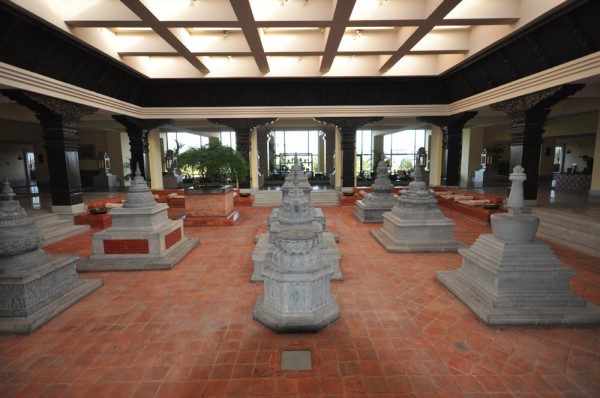
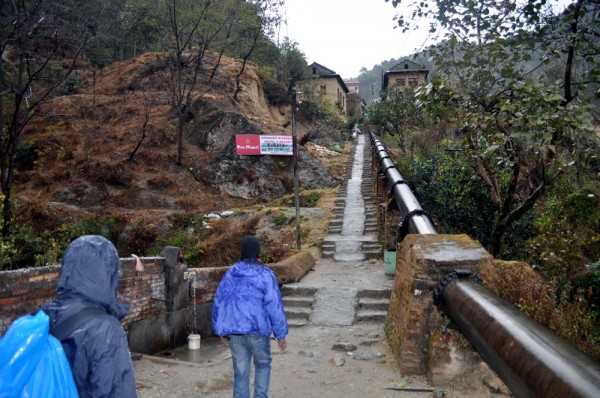
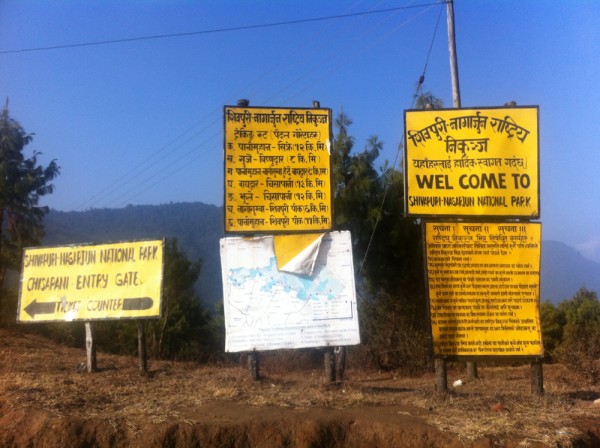
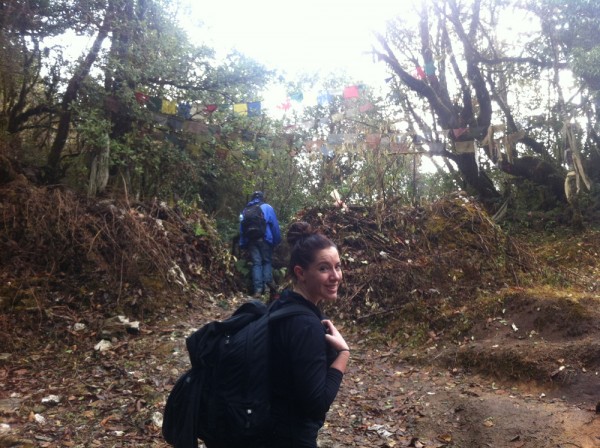
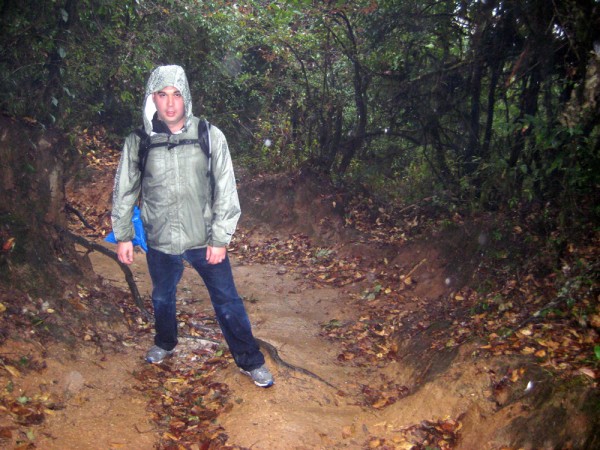
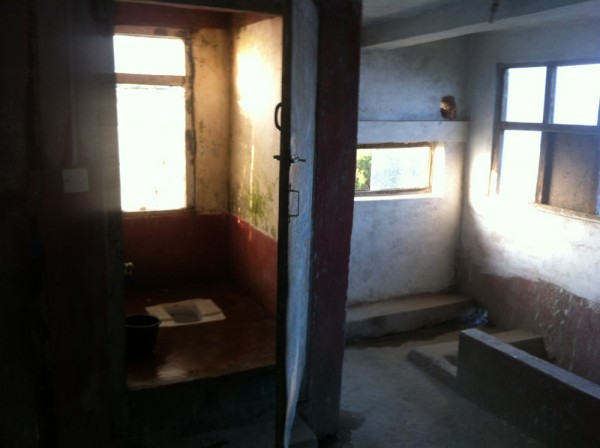
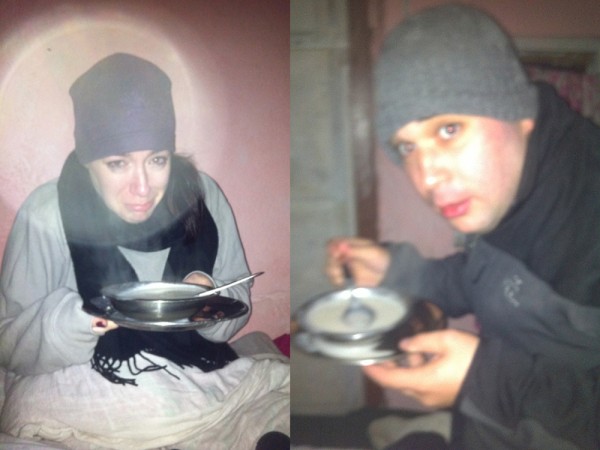
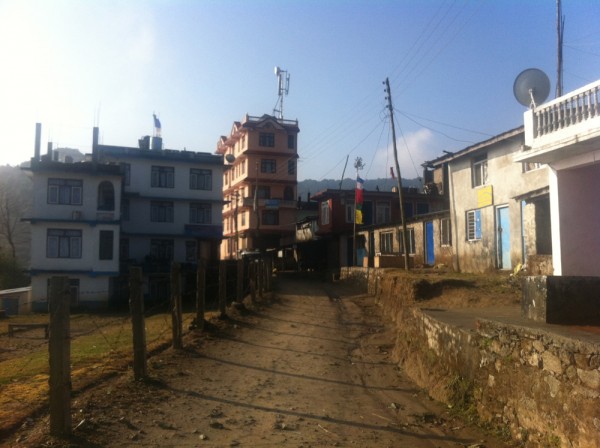
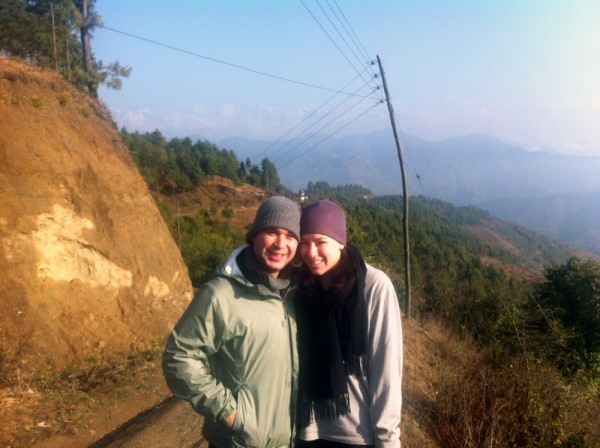
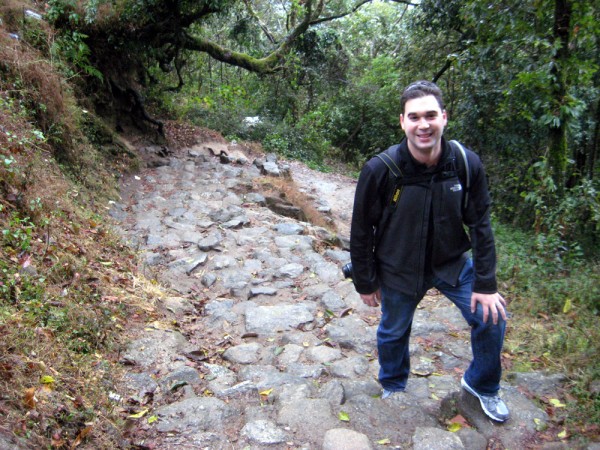
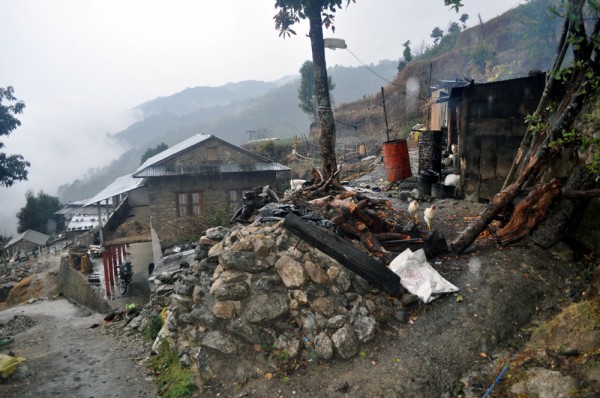
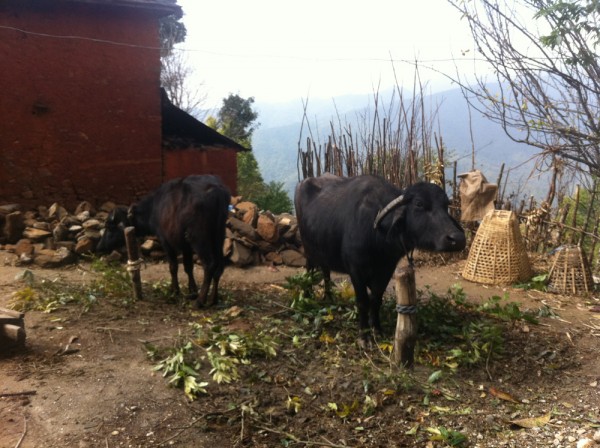











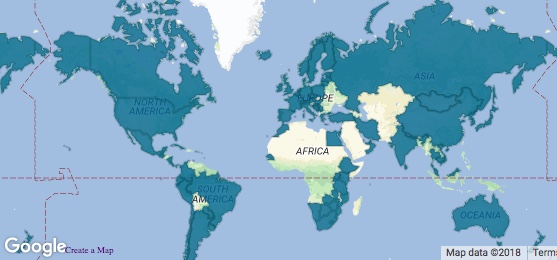



What Is a Trek?
Whether you begin your trek at a road head or fly into a remote mountain airstrip, a large part of it will be in the Middle Hills region at elevations between 500 and 3000 meters. In this region, there are always well-developed trails through villages and across mountain passes. Even at high altitudes there are intermittent settlements used during summer by shepherds, so the trails, though often indistinct, are always there. You can easily travel on any trail without the aid of ropes or mountaineering skills. There are rare occasions when there is snow on the trail, and on some high passes it might be necessary to place a safety line for your companions or porters if there is deep snow. Still, alpine techniques are almost never used on a traditional trek. Anyone who has walked extensively in the mountains has all the skills necessary for an extended trek in Nepal.
Some treks venture near glaciers, even cross the foot of them, most treks does not allow the fulfillment of any Himalayan mountaineering ambitions. Nepal’s mountaineering regulations allow trekkers to climb 18 specified peaks with a minimum of formality, but you must still make a few advance arrangements for such climbs. Many agents offer so-called climbing treks which include the ascent of one of these peaks as a feature of the trek. There are a few peaks that, under ideal conditions, are within the resources of individual trekkers. A climb can be arranged in Kathmandu if conditions are right, but a climb of one of the more difficult peaks should be planned well in advance.
Trekking in nepal take you through a country that has captured the imagination of mountaineers and explorers for more than 100 years. You can meet people in the mountain villages whose lifestyle has not changed still in generations. Most people like and trust foreigners. Nepal is in-depended country.
Adventure Holidays in nepal
Many of the values associated with a hiking trip at home do not have the same importance during a trek in Nepal. Isolation is traditionally a crucial element of any wilderness experience but in Nepal it is impossible to get completely away from people, except for short times or at extremely high elevations. Environmental concerns must include the effects of conservation measures on rural people and the economic effects of tourism on indigenous populations. Even traditional national park management must be adapted because there are significant population centers within Sagarmatha (Mt Everest) and Langtang national parks.
The Himalaya are extended from eastern India Assam west to Afghanistan. It is a chain of the highest mountains on earth and it covers a region of deep religious and cultural traditions as well as an amazing diversity of people. Trekking in Nepal is a special mountain experience.
Adventure Trip in nepal Villages embrace many ethnic groups and cultures. The terrain changes from tropical jungle to high glaciated peaks in only 150 km. From the start, the towering peaks of the Himalaya provide one of the highlights of a trek. As your plane approaches Kathmandu these peaks appear to be small clouds on the horizon. The mountains become more definable and seem to reach impossible heights as you get closer and finally land at Kathmandu’s Tribhuvan Airport.
thanks for sharing in website………
Reading this post was so hilarious because I have been to the same place in Chisapani and experienced the same sights and shivers (and it wasn’t even raining when I went there). But that hasn’t discouraged me from trekking in Nepal. Nevertheless kudos to both of you for surviving that night :]
Thanks Sneezestar! Glad you enjoyed it. Despite the challenges, we did really enjoy Nepal!
Stumbled upon your blog while browsing for short treks across Katmandu Valley. I’m thinking of doing the same trek as yours but I’m worried that I might also end up soaked and freezing the whole night. I’ll be in Nepal this July, which is the monsoon season. Ha! I already emailed Utmost Adventure. Thanks for sharing.
Good luck, Mark! Definitely take your guide’s advice if he suggests driving. Also, truly waterproof gear is key. Wrap your things in plastic bags inside of your backpack and bring very few electronics. Prepare for zero electricity.